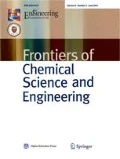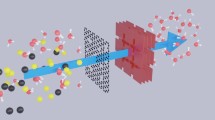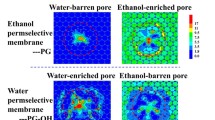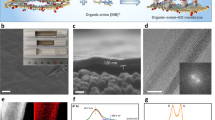Abstract
Graphene oxide (GO) membranes have received considerable attention owing to their outstanding water-permeation properties; however, the effect of the membrane’s microstructures (such as the distribution of oxidized and pristine regions) on the transport mechanism remains unclear. In this study, we performed molecular simulations to explore the permeation of a water-ethanol mixture using a new type of Janus GO membranes with different orientations of oxidized and pristine surfaces. The results indicate that the oxidized upper surface endows the GO membrane with considerable water-capture capability and the in-built oxidized interlayer promotes the effective vertical diffusion of water molecules. Consequently, using the optimized Janus GO membrane, infinite water selectivity and outstanding water flux (~40.9 kg·m−2·h−1) were achieved. This study contributes to explaining the role of oxidized regions in water permeation via GO membranes and suggests that Janus GO membranes could be used as potential candidates for water-ethanol separation.

Similar content being viewed by others
References
Nair R R, Wu H A, Jayaram P N, Grigorieva I V, Geim A K. Unimpeded permeation of water through helium-leak-tight graphene-based membranes. Science, 2012, 335(6067): 442–444
Wei N, Peng X, Xu Z. Understanding water permeation in graphene oxide membranes. ACS Applied Materials & Interfaces, 2014, 6(8): 5877–5883
Chen B, Jiang H, Liu X, Hu X. Water transport confined in graphene oxide channels through the rarefied effect. Physical Chemistry Chemical Physics, 2018, 20(15): 9780–9786
Chen B, Jiang H, Liu H, Liu K, Liu X, Hu X. Thermal-driven flow inside graphene channels for water desalination. 2D Materials, 2019, 6(3): 035018
Joshi R K, Carbone P, Wang F C, Kravets V G, Su Y, Grigorieva I V, Wu H A, Geim A K, Nair R R. Precise and ultrafast molecular sieving through graphene oxide membranes. Science, 2014, 343(6172): 752–754
Chen B, Jiang H, Liu X, Hu X. Molecular insight into water desalination across multilayer graphene oxide membranes. ACS Applied Materials & Interfaces, 2017, 9(27): 22826–22836
Yuan Z, Benck J D, Eatmon Y, Blankschtein D, Strano M S. Stable, temperature-dependent gas mixture permeation and separation through suspended nanoporous single-layer graphene membranes. Nano Letters, 2018, 18(8): 5057–5069
He G, Huang S, Villalobos L F, Zhao J, Mensi M, Oveisi E, Rezaei M, Agrawal K V. High-permeance polymer-functionalized single-layer graphene membranes that surpass the postcombustion carbon capture target. Energy & Environmental Science, 2019, 12(11): 3305–3312
Devanathan R, Chase-Woods D, Shin Y, Gotthold D W. Molecular dynamics simulations reveal that water diffusion between graphene oxide layers is slow. Scientific Reports, 2016, 6(1): 29484
Yang E, Ham M H, Park H B, Kim C M, Song J, Kim I S. Tunable semi-permeability of graphene-based membranes by adjusting reduction degree of laminar graphene oxide layer. Journal of Membrane Science, 2018, 547: 73–79
Zolezzi C, Ihle C F, Angulo C, Palma P, Palza H. Effect of the oxidation degree of graphene oxides on their adsorption, flocculation, and antibacterial behavior. Industrial & Engineering Chemistry Research, 2018, 57(46): 15722–15730
Balapanuru J, Manga K K, Fu W, Abdelwahab I, Zhou G, Li M, Lu H, Loh K P. Desalination properties of a free-standing, partially oxidized few-layer graphene membrane. Desalination, 2019, 451: 72–80
Wei Y, Zhang Y, Gao X, Ma Z, Wang X, Gao C. Multilayered graphene oxide membranes for water treatment: a review. Carbon, 2018, 139: 964–981
Lee B, Suh D W, Hong S P, Yoon J. A surface-modified EDTA-reduced graphene oxide membrane for nanofiltration and antibiofouling prepared by plasma post-treatment. Environmental Science. Nano, 2019, 6(7): 2292–2298
Ban S, Xie J, Wang Y, Jing B, Liu B, Zhou H. Insight into the nanoscale mechanism of rapid H2O transport within a graphene oxide membrane: impact of oxygen functional group clustering. ACS Applied Materials & Interfaces, 2016, 8(1): 321–332
Willcox J A, Kim H J. Molecular dynamics study of water flow across multiple layers of pristine, oxidized, and mixed regions of graphene oxide. ACS Nano, 2017, 11(2): 2187–2193
Chen B, Jiang H, Liu X, Hu X. Observation and analysis of water transport through graphene oxide interlamination. Journal of Physical Chemistry C, 2017, 121(2): 1321–1328
Huang K, Liu G, Lou Y, Dong Z, Shen J, Jin W. A graphene oxide membrane with highly selective molecular separation of aqueous organic solution. Angewandte Chemie International Edition in English, 2014, 53(27): 6929–6932
Yang J Z, Liu Q L, Wang H T. Analyzing adsorption and diffusion behaviors of ethanol/water through silicalite membranes by molecular simulation. Journal of Membrane Science, 2007, 291(1): 1–9
Lee W, Kang P K, Kim A S, Lee S. Impact of surface porosity on water flux and structural parameter in forward osmosis. Desalination, 2018, 439: 46–57
David C T, Grossman J C. Water desalination across nanoporous graphene. Nano Letters, 2012, 12(7): 3602–3608
Liu Q, Wu Y, Wang X, Liu G, Zhu Y, Tu Y, Lu X, Jin W. Molecular dynamics simulation of water-ethanol separation through monolayer graphene oxide membranes: significant role of O/C ratio and pore size. Separation and Purification Technology, 2019, 224: 219–226
Peng P, Shi B, Lan Y. A review of membrane materials for ethanol recovery by pervaporation. Separation Science and Technology, 2010, 46(2): 234–246
Khoonsap S, Rugmai S, Hung W S, Lee K R, Klinsrisuk S, Amnuaypanich S. Promoting permeability-selectivity anti-trade-off behavior in polyvinyl alcohol (PVA) nanocomposite membranes. Journal of Membrane Science, 2017, 544: 287–296
Delley B. An all-electron numerical method for solving the local density functional for polyatomic molecules. Journal of Chemical Physics, 1990, 92(1): 508–517
Wang Y, He Z, Gupta K M, Shi Q, Lu R. Molecular dynamics study on water desalination through functionalized nanoporous graphene. Carbon, 2017, 116: 120–127
Xu X L, Lin F W, Du Y, Zhang X, Wu J, Xu Z K. Graphene oxide nanofiltration membranes stabilized by cationic porphyrin for high salt rejection. ACS Applied Materials & Interfaces, 2016, 8(20): 12588–12593
Sun H. COMPASS: an ab initio force-field optimized for condensed-phase applications—overview with details on alkane and benzene compounds. Journal of Physical Chemistry B, 1998, 102(38): 7338–7364
Hess B, Kutzner C, van der Spoel D, Lindahl E. GROMACS 4: algorithms for highly efficient, load-balanced, and scalable molecular simulation. Journal of Chemical Theory and Computation, 2008, 4(3): 435–447
Yang X, Yang X, Liu S. Molecular dynamics simulation of water transport through graphene-based nanopores: flow behavior and structure characteristics. Chinese Journal of Chemical Engineering, 2015, 23(10): 1587–1592
Liu Q, Gupta K M, Xu Q, Liu G, Jin W. Gas permeation through double-layer graphene oxide membranes: the role of interlayer distance and pore offset. Separation and Purification Technology, 2019, 209: 419–425
Jorgensen W L, Chandrasekhar J, Madura J D, Impey R W, Klein M L. Comparison of simple potential functions for simulating liquid water. Journal of Chemical Physics, 1983, 79(2): 926–935
Jorgensen W L, Maxwell D S, Tirado-Rives J. Development and testing of the OPLS all-atom force field on conformational energetics and properties of organic liquids. Journal of the American Chemical Society, 1996, 118(45): 11225–11236
Wennberg C L, Murtola T, Páll S, Abraham M J, Hess B, Lindahl E. Direct-space corrections enable fast and accurate lorentz-berthelot combination rule lennard-jones lattice summation. Journal of Chemical Theory and Computation, 2015, 11(12): 5737–5746
Essmann U, Perera L, Berkowitz M L, Darden T, Lee H, Pedersen L G. A smooth particle mesh Ewald method. Journal of Chemical Physics, 1995, 103(19): 8577–8593
Vane L M. Review: membrane materials for the removal of water from industrial solvents by pervaporation and vapor permeation. Journal of Chemical Technology and Biotechnology (Oxford, Oxfordshire), 2019, 94(2): 343–365
Gui T, Zhang F, Li Y Q, Cui X, Wu X W, Zhu M H, Hu N, Chen X S, Kita H, Kondo M. Scale-up of NaA zeolite membranes using reusable stainless steel tubes for dehydration in an industrial plant. Journal of Membrane Science, 2019, 583: 180–189
Zhao D, Zhao J, Ji Y, Liu G, Liu S, Jin W. Facilitated water-selective permeation via PEGylation of graphene oxide membrane. Journal of Membrane Science, 2018, 567: 311–320
Huang K, Liu G, Lou Y, Dong Z, Shen J, Jin W. A graphene oxide membrane with highly selective molecular separation of aqueous organic solution. Angewandte Chemie International Edition, 2014, 53(27): 6929–6932
Chang X, Zhu L, Xue Q, Li X, Guo T, Li X, Ma M. Charge controlled switchable CO2/N2 separation for g-C10N9 membrane: insights from molecular dynamics simulations. Journal of CO2 Utilization, 2018, 26: 294–301
Obst S, Bradaczek H. Molecular dynamics study of the structure and dynamics of the hydration shell of alkaline and alkaline-earth metal cations. Journal of Physical Chemistry, 1996, 100(39): 15677–15687
Chen B, Jiang H, Liu X, Hu X. Observation and analysis of water transport through graphene oxide interlamination. Journal of Physical Chemistry C, 2017, 121(2): 1321–1328
Ye H, Zhang H, Zheng Y, Zhang Z. Nanoconfinement induced anomalous water diffusion inside carbon nanotubes. Microfluidics and Nanofluidics, 2011, 10(6): 1359–1364
Acknowledgements
This work was financially supported by the National Natural Science Foundation of China (Grant Nos. 21922805, 21776125). We are grateful to the High-Performance Computing Center of Nanjing Tech University for supporting the computational resources.
Author information
Authors and Affiliations
Corresponding author
Electronic Supplementary Material
Rights and permissions
About this article
Cite this article
Liu, Q., Chen, M., Mao, Y. et al. Theoretical study on Janus graphene oxide membrane for water transport. Front. Chem. Sci. Eng. 15, 913–921 (2021). https://doi.org/10.1007/s11705-020-1954-5
Received:
Accepted:
Published:
Issue Date:
DOI: https://doi.org/10.1007/s11705-020-1954-5




